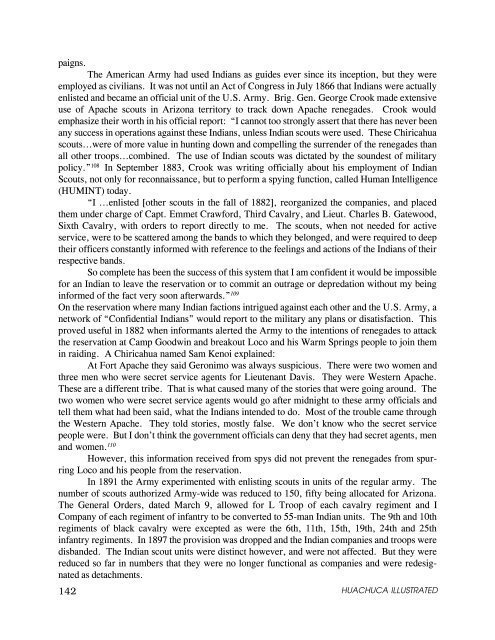Apache Campaigns - Fort Huachuca - U.S. Army
Apache Campaigns - Fort Huachuca - U.S. Army
Apache Campaigns - Fort Huachuca - U.S. Army
Create successful ePaper yourself
Turn your PDF publications into a flip-book with our unique Google optimized e-Paper software.
paigns.<br />
The American <strong>Army</strong> had used Indians as guides ever since its inception, but they were<br />
employed as civilians. It was not until an Act of Congress in July 1866 that Indians were actually<br />
enlisted and became an official unit of the U.S. <strong>Army</strong>. Brig. Gen. George Crook made extensive<br />
use of <strong>Apache</strong> scouts in Arizona territory to track down <strong>Apache</strong> renegades. Crook would<br />
emphasize their worth in his official report: “I cannot too strongly assert that there has never been<br />
any success in operations against these Indians, unless Indian scouts were used. These Chiricahua<br />
scouts...were of more value in hunting down and compelling the surrender of the renegades than<br />
all other troops...combined. The use of Indian scouts was dictated by the soundest of military<br />
policy.” 108 In September 1883, Crook was writing officially about his employment of Indian<br />
Scouts, not only for reconnaissance, but to perform a spying function, called Human Intelligence<br />
(HUMINT) today.<br />
“I ...enlisted [other scouts in the fall of 1882], reorganized the companies, and placed<br />
them under charge of Capt. Emmet Crawford, Third Cavalry, and Lieut. Charles B. Gatewood,<br />
Sixth Cavalry, with orders to report directly to me. The scouts, when not needed for active<br />
service, were to be scattered among the bands to which they belonged, and were required to deep<br />
their officers constantly informed with reference to the feelings and actions of the Indians of their<br />
respective bands.<br />
So complete has been the success of this system that I am confident it would be impossible<br />
for an Indian to leave the reservation or to commit an outrage or depredation without my being<br />
informed of the fact very soon afterwards.” 109<br />
On the reservation where many Indian factions intrigued against each other and the U.S. <strong>Army</strong>, a<br />
network of “Confidential Indians” would report to the military any plans or disatisfaction. This<br />
proved useful in 1882 when informants alerted the <strong>Army</strong> to the intentions of renegades to attack<br />
the reservation at Camp Goodwin and breakout Loco and his Warm Springs people to join them<br />
in raiding. A Chiricahua named Sam Kenoi explained:<br />
At <strong>Fort</strong> <strong>Apache</strong> they said Geronimo was always suspicious. There were two women and<br />
three men who were secret service agents for Lieutenant Davis. They were Western <strong>Apache</strong>.<br />
These are a different tribe. That is what caused many of the stories that were going around. The<br />
two women who were secret service agents would go after midnight to these army officials and<br />
tell them what had been said, what the Indians intended to do. Most of the trouble came through<br />
the Western <strong>Apache</strong>. They told stories, mostly false. We don’t know who the secret service<br />
people were. But I don’t think the government officials can deny that they had secret agents, men<br />
and women. 110<br />
However, this information received from spys did not prevent the renegades from spurring<br />
Loco and his people from the reservation.<br />
In 1891 the <strong>Army</strong> experimented with enlisting scouts in units of the regular army. The<br />
number of scouts authorized <strong>Army</strong>-wide was reduced to 150, fifty being allocated for Arizona.<br />
The General Orders, dated March 9, allowed for L Troop of each cavalry regiment and I<br />
Company of each regiment of infantry to be converted to 55-man Indian units. The 9th and 10th<br />
regiments of black cavalry were excepted as were the 6th, 11th, 15th, 19th, 24th and 25th<br />
infantry regiments. In 1897 the provision was dropped and the Indian companies and troops were<br />
disbanded. The Indian scout units were distinct however, and were not affected. But they were<br />
reduced so far in numbers that they were no longer functional as companies and were redesignated<br />
as detachments.<br />
142<br />
HUACHUCA ILLUSTRATED

















